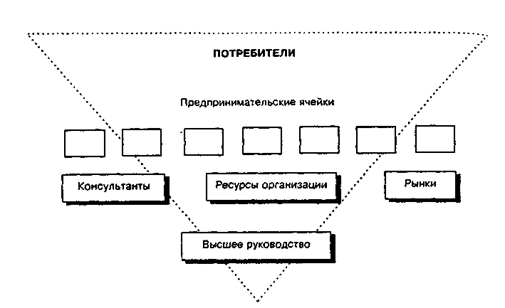home
 Management Management
 Management - Vikhanskiy OS Management - Vikhanskiy OS
|
Management - Vikhanskiy OS
4.4. Entrepreneurial organization
Rapid and dynamic changes of the last decade, which occurred in the external environment of business organizations, contributed to the development of a special type of organization, called entrepreneurial. The emergence of these organizations was associated with the need to create real economic values on a sustainable and permanent basis by seeking and implementing all the opportunities available in this direction. This also required the need to motivate employees to assume responsibility for the creation of these economic values. Finally, entrepreneurial structures as a way of rewarding individuals and groups were brought to life by the necessity of balancing the benefits and risks received and shared by individuals and groups.
Entrepreneurial structures in question are not to be identified with small business, business opening, investment projects and simply a way of quick enrichment. Entrepreneurial organizations are not related to the size of business, with a particular industry, with territory or with culture.
Entrepreneurial organizations are focused on growth and rely more on available opportunities than on controlled resources. Realization of these opportunities and the use of resources for this are often carried out on a short, episodic and phased basis. Control over resources is usually mediated (rent, loan, etc.). The management structure of an entrepreneurial organization is characterized by a small number of levels, flexibility and network construction. The activities of such an organization are usually evaluated not on the basis of productivity, but on the basis of efficiency. Motivation of entrepreneurial activity is based on finding opportunities and achieving results, rather than on the need for using resources. From the point of view of organizational structure, business structures are based on an individual initiative, and not on coordination, as is the case in traditional organizations. Concentrated development is replaced by development in many areas. In entrepreneurship, individual competence is more important than organizational competence. The key organizational factors are people, groups and their qualifications. In Fig. 8.11 is a schematic diagram of the structure of an entrepreneurial organization.

Fig. 8.11. Business Entity Scheme
Entrepreneurial organization from the standpoint of a structural view of it is an inverted pyramid, at the base of which is the leadership of this organization. At the same time the leadership not only changes its place, but also changes its basic functions. The main duty of the leadership of an entrepreneurial organization, instead of traditional control, is the full support of the efforts of workers doing business. Next below
The level of organization includes three main blocks. The key is the resources of the organization (people, money, time, technology, information, ideas, etc.). The task of this block is to provide resources for the efforts of workers doing business. The second unit is the units that define markets for business and transfer their development to those who do business. The third block consists of consultants, or rather, business coaches, who help their business and experience with their intuition. At the top of the inverted pyramid are business-doing business cells, focused on a particular market, where they search for and realize opportunities. These cells are actually small autonomous groups of workers, united by the business criterion they are doing. By status, they can be profit centers or even independent firms, or companies. Such a structural structure of an entrepreneurial organization "turns it face" to the consumer, brings it closer to him and allows him to react in a timely and flexible manner to changing his requirements. At the same time, the maximum possible delegation of rights and responsibilities to those who directly do business. The motivation of people and the effectiveness of their work are greatly increased.


Comments
When commenting on, remember that the content and tone of your message can hurt the feelings of real people, show respect and tolerance to your interlocutors even if you do not share their opinion, your behavior in the conditions of freedom of expression and anonymity provided by the Internet, changes Not only virtual, but also the real world. All comments are hidden from the index, spam is controlled.